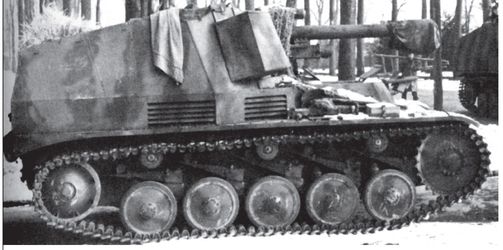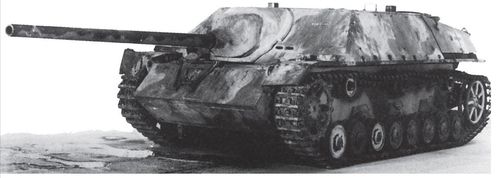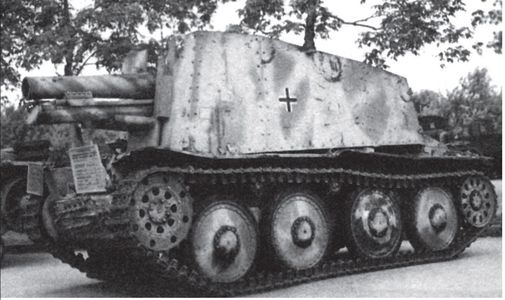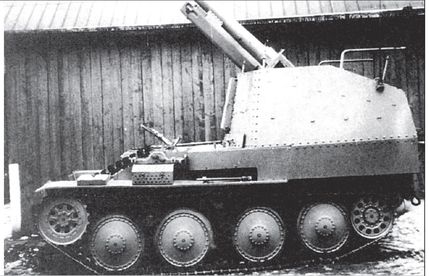Authors: Norbert Bacyk
Warszawa II (31 page)
One of Germany's most common armoured cars during WWII. Built on a chassis designed for armoured cars, it had 4-wheel drive and 4Ã4 steering. They were manufactured between 1935 and 1944. The 221 and the 222 were reconnaissance vehicles with standard features and roles. The 223, 260 and 261 models had higher capacity radio systems and functioned more as mobile communication centres in connection with reconnaissance missions. Approximately 2,200 were built, all told.

Production period:
1935 â 1944
Manufacturers:
Krupp, Horch
Tonnage:
4 â 4.8 tonnes
Crew:
221, 222, 223:3, 260, 261:4
Length:
4.8 meters
Width:
1.95 meters
Height:
1.80 meters
Wheel base:
280 cm
Ground clearance:
24 cm
Motor:
Horch 801 V- 8 Petrol
Engine capacity:
75 HP at 3600 rpm
Fuel capacity:
100 liters
Maximum speed:
80 km/h
Maximum range:
280 km
Armament:
221: 1 Ã MG 7.92 mm or 1Ã 2.8 cm
Panzerbuche
222: 1 Ã 20 mm KwK or 2.8 cm
Panzerbuche
223: 1 Ã 20 mm KwK
260, 261: 1 Ã MG 7.92 mm
Ammunition quantity:
20 mm â 250 shells (222, 223)
2.8 cm â 200 shells (221, 222)
7.92 mm â 2,500 rounds (221, 260, 261)
Armour strength:
Hull frontal:
14.5 mm (all models)
Hull sides:
8mm (all models)
Hull rear, roof, floor:
8 mm (all models)
Turret front:
14.5 mm (231, 232)
Turret sides:
14.4 mm (231, 232)

Based on the PzKpfw II and Germany's most common self-propelled artillery gun during WWII, the Wespe was hardly advanced and a very simply built vehicle. As usual, Germanys' armaments industry make use of their overproduction of dated equipment to come up with a more solution to a given problem.This was the case with the “Wespe”. The PzKpfw II was simplified by moving the engine, making space to install the big 10.5 cm howitzer in even such a small vehicle as the Pzkpfw II. The result was an extremely popular self-propelled gun. All told, approximately 1,000 were built in different versions.
Production period:
1943 â 1944
Manufacturer:
FAMO
Tonnage:
11 tonnes
Crew:
5
Length:
4.81 meters
Width:
2.28 meters
Height:
2.30 meters
Track width:
30 cm
Ground clearance:
34 cm
Motor:
Maybach HL 62 TR V-6 petrol
Engine capacity:
140 HP at 2,600rpm
Fuel capacity:
200 liters
Maximum speed:
40 km/h
Maximum range:
140 km
Armament:
1 Ã 10.5 le. FH. 18/2, 1 Ã 7.92 mm MG
Ammunition quantity:
10.5 cm â 32 shells, 7.92 mm â 600 rounds
Armour strength:
Hull frontal:
30 mm
Hull sides:
15 mm
Hull rear, roof floor:
15 mm
Turret front:
15 mm
Turret sides:
15 mm

Initially, the design of this vehicle was completed as early as 1942. From the very first, it was called the “Sturmgeschütz neue art” reflecting its purpose of replacing the StuG III as a mobile anti-tank artillery gun. However, it wasn't until January of 1944 that Hitler approved it and production began. To begin with, it was equipped with an L/48 gun but by the late-summer of 1944 several more L/70 guns became available so that by November 1944 only the panzer IV/70 variant was in production. There were two additional variations: the Alkett (A) and the Vomag (V) that shared in the vehicle's production right up until May 1945. The total number produced breaks down as follows: 769 examples of the L/48, 930 of the Vomag L/70 variation, and 278 of the Alkett L/70. The vehicle was extremely effective and very popular. Note: During the 1950s and 60s West Germany built a series of mobile PV- guns which were directly reminiscent of the Jagdpanzer IV design! The lines could be clearly observed.
Production period:
1944
Manufacturer:
Vomag
Tonnage:
24 tonnes
Crew:
4
Length:
4.87 meters
Width:
2.63 meters
Height:
2.17 meters
Track width:
35 cm
Ground clearance:
42 cm
Motor:
Maybach HL 120 TRM V-12 petrol
Engine capacity:
265 HP at 2,600rpm
Fuel capacity:
470 liters
Maximum speed:
40 km/h
Maximum range:
210 km
Armament:
1 Ã 7.5 cm Pak 39 L/48cm, 1 Ã 7.92 mm MG
Ammunition quantity:
7.5 cm â 79 shells, 7.92 mm â 600 rounds
Armour strength:
Hull frontal:
80 mm
Hull sides:
40 mm
Hull rear, roof, floor:
40 mm
Turret front:
unavailable
Turret sides:
unavailable

Production period:
1944 â 1945
Manufacturers:
Vomag, Alkett
Tonnage:
27 tonnes
Crew:
4
Length:
8.87 meters
Width:
2.90 meters
Height:
2.20 meters
Track width:
40 cm
Clearance:
40 cm
Motor:
Maybach HL 120 TRM V-12 Petrol
Engine capacity:
265 HP at 2,600rpm
Fuel capacity:
470 liters
Maximum speed:
38 km/h
Maximum range:
200 km
Armament:
1 Ã 7.5 cm K.w.K 42 L/70, 1 Ã 7.92 mm MG
Ammunition quantity:
7.5 cm â 90 shells
7.92 mm â 1,200 rounds
Armour strength:
Hull frontal:
80 mm
Hull sides:
40 mm
Hull rear, roof, floor:
40 mm
Turret front:
unavailable
Turret sides:
unavailable

A principle of the so called Blitzkrieg doctrine was that the infantry must be mechanised, and also, their support weapons. For this reason, Germany sought ways to mechanise the heavy infantry guns (s.I.G 15cm). During 1940 and 1941, the PzKpfw I and II were used to mechanise the s.I.G â however, satisfactory solutions were never forthcoming. The 38(t) proved a much better solution. The vehicle was clearly more suited than its predecessors to transporting such a heavy gun. True, it was lightly armoured, but it was never intended to be used on the frontline, but rather as indirect support to the infantry. In total, 400 were manufactured in two production runs between 1942 and 1944, all based upon two different versions of the 38(t).
Production period:
1942 â 1943
Manufacturers:
Praga CKD, BMM, Skoda
Tonnage:
11.5 tonnes
Crew:
5
Length:
5.6 meters
Width:
2.15 meters
Height:
2.40 meters
Track width:
29 cm
Ground clearance:
40 cm
Motor:
Praga TNHPS/II V-6 petrol
Engine capacity:
150 HP at 2,600 rpm
Fuel capacity:
218 litres
Maximum speed:
42km/h
Maximum range:
185 km
Armament:
1 Ã 15 cm s.I.G 33/1
1 Ã 7.92 mm MG
Ammunition quantity:
15 cm â 15 shells
7.92 mm â 600 rounds
Armour strength:
Hull frontal:
50 mm
Hull sides:
10 mm
Hull rear, roof, floor:
10 mm
Turret front:
10 mm
Turret sides:
10 mm

Production period:
1943 â 1944
Manufacturers:
Praga, CKD, BMM, Skoda
Tonnage:
11.5 tonnes
Crew:
5
Length:
4.8 meters
Width:
2.15 meters
Height:
2.40 meters
Track width:
29 cm
Ground clearance:
40 cm
Motor:
Praga AC/2,800 V-6 petrol
Engine capacity:
150 HP at 2,800rpm
Fuel capacity:
320 liters
Maximum speed:
42 km/h
Maximum range:
260 km
Armament:
1 Ã 15 cm s.I.G 33/1, 1 Ã 7.92mm MG
Ammunition quantity:
7.5 cm â 15 shells, 7.92 mm â 600 rounds
Armour strength:
Hull frontal:
60 mm
Hull sides:
15 mm
Hull rear, roof, floor:
15 mm
Turret front:
15 mm
Turret sides:
15 mm
